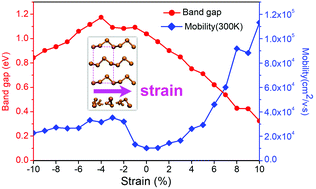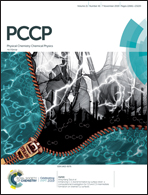Strain engineering of the electronic and transport properties of monolayer tellurenyne†
Abstract
Two-dimensional (2D) materials exhibiting quality electronic properties such as suitable band gap, giant Rashba effect and high carrier mobility are essential for promising applications in electronics and spintronics. Strain engineering has been recognized as an effective strategy to engineer the atomic and electronic properties of 2D materials. Herein, based on density functional theory, we demonstrate that the electronic properties of tellurenyne can be tuned well by using uniaxial strain. We find that tellurenyne retains the unique noncovalent bond structure and exhibits good stability under the uniaxial strain. Meanwhile, the band gap of tellurenyne can be tuned to a large scale (0.33–1.18 eV and 0.73–1.27 eV under the uniaxial strain along and perpendicular to the chain direction, respectively). Under 10% tension strain along the chain direction, the Rashba constant reaches 2.96 eV Å, belonging to giant Rashba systems. More importantly, the hole mobility of tellurenyne along the chain direction reaches 1.1 × 105 cm2 V−1 s−1 under 10% tension strain along the chain direction, which is one order of magnitude larger than that of phosphorene. Therefore, these remarkable electronic properties of tellurenyne engineered by using strain indicate its potential applications in electronics and spintronics.



 Please wait while we load your content...
Please wait while we load your content...